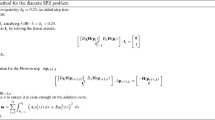Abstract
We develop a new homotopy method for solving multiparameter eigenvalue problems (MEPs) called the fiber product homotopy method. For a k-parameter eigenvalue problem with matrices of sizes \(n_1,\ldots ,n_k = O(n)\), fiber product homotopy method requires deformation of O(1) linear equations, while existing homotopy methods for MEPs require O(n) nonlinear equations. We show that the fiber product homotopy method theoretically finds all eigenpairs of an MEP with probability one. It is especially well-suited for a class of problems we call dimension-deficient singular problems that are generic with respect to intrinsic dimension, as the fiber product homotopy method is provably convergent with probability one for such problems as well, a fact borne out by numerical experiments. More generally, our numerical experiments indicate that the fiber product homotopy method significantly outperforms the standard Delta method in terms of accuracy, with consistent backward errors on the order of \(10^{-16}\) without any use of extended precision. In terms of speed, it significantly outperforms previous homotopy-based methods on all problems and outperforms the Delta method on larger problems, and is also highly parallelizable. We show that the fiber product MEP that we solve in the fiber product homotopy method, although mathematically equivalent to a standard MEP, is typically a much better conditioned problem.








Similar content being viewed by others
Notes
More precisely, we solve \(H_{i}(\varvec{\lambda }_{i})\varvec{x}_{i}=0\), \(G_1 = \cdots = G_k = 0\), \(i=1,\ldots ,k\), where each \(G_i :{\mathbb {C}}^{k^2} \rightarrow {\mathbb {C}}^{k-1}\) is a linear function of \(\varvec{\lambda }_{1},\ldots ,\varvec{\lambda }_{k}\), chosen so that the resulting system is equivalent to (4). See Sect. 5.2.
Here “generic” is used in its usual sense in algebraic geometry. Those unfamiliar with this notion may assume that it is synonymous with “random.”
This is an algebraic geometry term that implies the polynomial \(\det H_i(\varvec{\lambda }_i)\) is square-free.
The example is implemented in our GitHub codes at https://github.com/JoseMath/MEP_Homotopy/blob/master/MATLAB/examples/demo_flutter1.m for aerospace engineering [19], which remains a challenge for our method. In general, when the solutions to (3) are not the same as the regular eigenpairs of the MEP, the fiber product homotopy method may lose some regular eigenpairs. To address this issue, one has to know the connection between the \(H_i (\lambda )\) and the corresponding system of generalized eigenvalue problems on \(\varDelta \)-matrices but this is unfortunately not well-understood.
These are respectively right and left eigenvectors of the polynomial matrix.
References
Allgower, E.L., Georg, K.: Introduction to Numerical Continuation Methods. Classics in Applied Mathematics, vol. 45. SIAM, Philadelphia (2003)
Atkinson, F.V.: Multiparameter Eigenvalue Problems. Academic Press, New York (1972)
Atkinson, F.V., Mingarelli, A.B.: Multiparameter eigenvalue problems: Sturm-Liouville theory. CRC Press, Boca Raton (2011)
Bates, D., Gross, E., Leykin, A., Rodriguez, J.: Bertini for Macaulay 2. preprint arXiv:1310.3297 (2013)
Blum, L., Cucker, F., Shub, M., Smale, S.: Complexity and Real Computation. Springer, New York (1998)
Bürgisser, P.: Condition of intersecting a projective variety with a varying linear subspace. SIAM J. Appl. Algebra Geom. 1(1), 111–125 (2017)
Bürgisser, P., Cucker, F.: Condition, Grundlehren der Mathematischen Wissenschaften, vol. 349. Springer, Heidelberg (2013)
Dong, B., Yu, B., Yu, Y.: A homotopy method for finding all solutions of a multiparameter eigenvalue problem. SIAM J. Matrix Anal. Appl. 37(2), 550–571 (2016)
Grayson, D.R., Stillman, M.E.: Macaulay2, a software system for research in algebraic geometry. Available at http://www.math.uiuc.edu/Macaulay2/
Hartshorne, R.: Algebraic Geometry. Graduate Texts in Mathematics, vol. 52. Springer, New York (1977)
Hauenstein, J.D., Rodriguez, J.I., Sottile, F.: Numerical computation of Galois groups. Found. Comput. Math. 2, 95 (2017)
Hauenstein, J.D., Wampler, C.W.: Unification and extension of intersection algorithms in numerical algebraic geometry. Appl. Math. Comput. 293, 226–243 (2017)
Hochstenbach, M.E., Muhič, A., Plestenjak, B.: On linearizations of the quadratic two-parameter eigenvalue problem. Linear Algebra Appl. 436(8), 2725–2743 (2012)
Hochstenbach, M.E., Plestenjak, B.: Backward error, condition numbers, and pseudospectra for the multiparameter eigenvalue problem. Linear Algebra Appl. 375, 63–81 (2003)
Li, T.Y.: Numerical solution of multivariate polynomial systems by homotopy continuation methods. In: Acta Numerica, 1997, Acta Numeric, vol. 6, pp. 399–436. Cambridge University Press, Cambridge (1997)
Mazzola, G., Milmeister, G., Weissmann, J.: Comprehensive Mathematics for Computer Scientists, vol. 1, 2nd edn. Universitext. Springer, Berlin (2006)
Hochstenbach, M.E., Muhič, A., Plestenjak, B.: On the quadratic two-parameter eigenvalue problem and its linearization. Linear Algebra Appl. 432(10), 2529–2542 (2010)
Plestenjak, B., Gheorghiu, C.I., Hochstenbach, M.E.: Spectral collocation for multiparameter eigenvalue problems arising from separable boundary value problems. J. Comput. Phys. 298, 585–601 (2015)
Pons, A.D.: Aeroelastic flutter as a multiparameter eigenvalue problem, Master’s Thesis, University of Canterbury (2015). Retrieved March 9, 2021, from https://ir.canterbury.ac.nz/handle/10092/11265
Sommese, A.J., Wampler, C.W.: Exceptional sets and fiber products. Found. Comput. Math. 8(2), 171–196 (2008)
Sommese, A.J., Wampler, C.W.: The Numerical Solution of Systems of Polynomials. World Scientific Publishing Co. Pte. Ltd., Hackensack (2005)
Sturmfels, B.: The Hurwitz form of a projective variety. J. Symbolic Comput. 79(1), 186–196 (2017)
Volkmer, H.: Multiparameter Eigenvalue Problems and Expansion Theorems. Lecture Notes in Mathematics, vol. 1356. Springer, Berlin (1988)
Zhang, T., Law, K.H., Golub, G.H.: On the homotopy method for perturbed symmetric generalized eigenvalue problems. SIAM J. Sci. Comput. 19(5), 1625–1645 (1998)
Acknowledgements
We are extremely grateful for the reviewer’s exceptionally helpful comments and suggestions that led to a much improved article.
Author information
Authors and Affiliations
Corresponding author
Additional information
Publisher's Note
Springer Nature remains neutral with regard to jurisdictional claims in published maps and institutional affiliations.
The work in this article is generously supported by DARPA D15AP00109, HR00112190040, and NSF IIS 1546413, DMS 1854831. LHL has also received support from the Eckhardt Faculty Fund. The work of JIR is supported by the College of Letters and Science, UW-Madison.
Rights and permissions
About this article
Cite this article
Rodriguez, J.I., Du, JH., You, Y. et al. Fiber product homotopy method for multiparameter eigenvalue problems. Numer. Math. 148, 853–888 (2021). https://doi.org/10.1007/s00211-021-01215-6
Received:
Revised:
Accepted:
Published:
Issue Date:
DOI: https://doi.org/10.1007/s00211-021-01215-6




